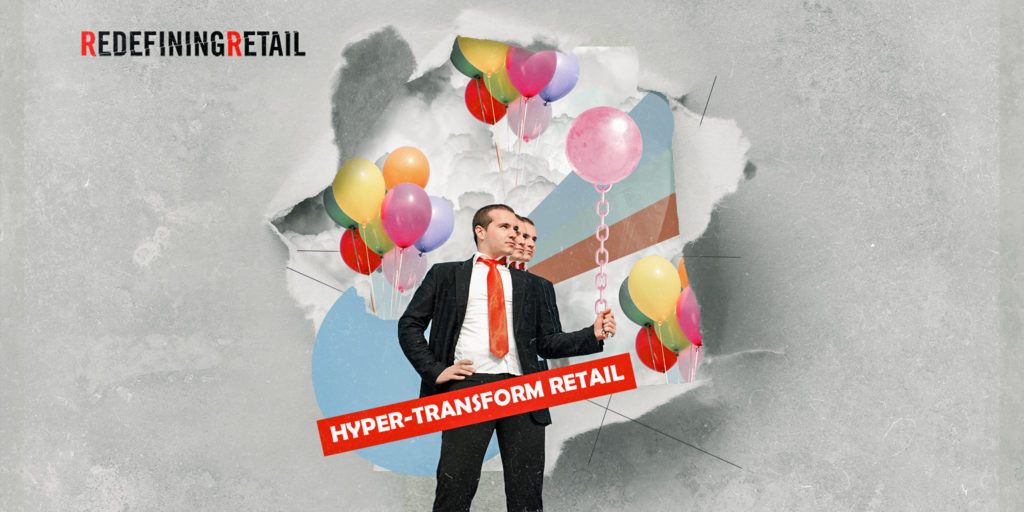Using experiential transformation to save America’s brick-and-mortar stores and malls.
By Robb Wagner—Written September, 2019 (pre-COVID-19 pandemic)

Every moment of crisis is an opportunity. When a threat arises in the primal world, we have two choices: Fight or Flight. But smart C-suite leaders know that in business, there’s a third option: Fight, Flight or Transform. Transformation is how companies like Netflix1 and IBM2 continue to remain relevant in a rapidly changing consumer landscape. Transformation is how Play-Doh3 went from being a 1930’s wall cleaner to one of Hasbro’s top-performing toy products.4
And transformation is how America’s brick and mortar stores can go from barely-surviving to traffic-driving in the next five years.
What analysts are now calling the Retail Apocalypse has been a topic of much speculation. Thanks to a perfect storm of factors — the Great Recession, a digitally-inspired exodus from brick-and-mortar shopping, changing cultural attitudes and values — it was estimated that 75,000 stores would close by 2026.5
But not all retail stores are struggling. Some are even gaining market share.6,7 To be among the profitable few, retailers need to take an honest look at their own purpose and the consumer needs they meet. It is only in examining the past and taking stock of the present that we can write the future.
The very first mall… wasn’t. As far back as the eighteenth century, the word “mall” meant a “shaded walk serving as a promenade.8” This definition would serve it well until 1954, when architect Victor Gruen debuted what is considered America’s first modern indoor shopping mall in Edina, Minnesota. He called it a “mall” because it was modeled after the fountain-filled promenades and gathering spaces of his youth in Vienna, Austria.9 In response to growing post-war suburban sprawl in the U.S., Gruen had envisioned a purposeful “third place10” where Americans could spend quality time in peace, away from traffic and smog. And virtually every shopping mall built since has been modeled after that first creation.
But here’s where this history lesson gets really relevant: the inventor of the Great American Shopping Mall meant for it to be about so much more than shopping.11 Gruen originally envisioned malls as mixed-use facilities that could address environmental, commercial and sociological problems. He imagined them as true mixed-use spaces, filled with shops, apartments, offices, medical centers, child-care facilities, libraries and bomb shelters (it was the fifties, after all).
Although the consumer-driven, retail-heavy model Americans got instead was ultimately a success for several decades, it’s now time for the industry to do some serious soul-searching.
HOW TO SURVIVE: REINVENT OR REVIVE?
One effort to save shopping malls realigns with Gruen’s original intent. “You’ll find DMVs, town halls, and libraries in malls increasingly… Main Street was killed by the mall, so developers are trying to build new downtowns inside the malls,” explains June Williamson, author of “Retrofitting Suburbia.12”
The average shopper used to spend hours in a mall, but today they spend less than an hour.13 Housing non-retail services is one way to lure consumers back into malls and keep them there. But is it really an effective tool to promote retail sales? After being held captive in a line for twenty minutes waiting on your Driver’s License renewal, how inspired do you feel to buy a new outfit?
Savvy developers have realized that in order to create a successful retail environment, entertainment must be built-in. According to Richard Florida, author of The New Urban Crisis, “…the stores that are drawing in customers are those that emphasize experiences.14”
One case in point is The Grove in Los Angeles, an outdoor shopping mall complete with a mini main street, retro-style trolley, dancing fountain and Summer concert series. You could say it’s been a success — the center sees more visitors per day than Disneyland.15 Another is American Dream in New Jersey, an upcoming three million square foot center that boasts a ratio of 55% entertainment to 45% retail. When completed, it will house a ski run, DreamWorks water park, Nickelodeon Universe theme park, Legoland Discovery Center, ice-skating rink, Ferris wheel and indoor garden.16,17
According to Uma Karmarkar, a neuro-economist at University of California San Diego, these types of fun activities attach a brand memory to a positive experience, potentially giving the same type of adrenaline-rush that happens when one makes a purchase.16 But does all that adrenaline lead to actual retail purchases? The Walt Disney Company’s financial statements say that it does. Their theme park retail sales continue to drive significant revenue growth18 at a time when America’s overall retail purchases see only minor gains.19
But here’s the thing. You don’t need to build a theme park to generate more store traffic. Here are 5 ways you can use the power of experiential transformation to enhance your environment and boost revenue.
1. BECOME AN ENTERTAINMENT LEADER.
Marketing expert Sally Hogshead puts it bluntly: “Different is better than better.20” As more online and offline experiences compete for a slice of consumers’ attention, retailers need to continually innovate in order to stay relevant. Cruise lines, in a parallel industry you could call the “mall of travel,” have seen steady growth, thanks to their agenda of relentless innovation.21 Take a cue from their playbook and invest in a flexible entertainment infrastructure that includes LED screens and convertible spaces in order to deliver fresh entertainment that keeps shoppers coming back for new experiences.
2. REINVENT USEFULNESS.
The best business innovators solve a problem.22 For shopping malls losing sales to online retailers that are perceived to offer lower prices23, solving consumers’ budget-woes and unemployment issues could offer a surprisingly synergistic fit. Housing co-working spaces and job training centers is one way to support and build your customer base, but replacing retail tenants with corporate ones isn’t the only option. Hosting one-off seminars, immersive tech training experiences, job fairs and networking events is another. At a minimum, boosting your work-friendly infrastructure (wi-fi, laptop lounge spaces, 360o teleconferencing rooms and caffeinated food court options) will help attract mobile workers and business travelers to your facility.
3. BE SHARE-WORTHY.
Create experiences that are meant to be seen, heard, felt & shared. At Stimulated-Inc., we call these Ultra-Sensory Experiences™. Selfies and online sharing aren’t going anywhere, and full-fledged Insta-destinations are now being built around them.24 Installing a few wall graphics isn’t a sustainable way to garner repeat visits, but it does provide a clue about where to start. Today’s shoppers are inherently visual. But to create an ongoing share-worthy relationship with them, your installation should be both flexible and emotional. According to a recent Deloitte report, “In an industry shifting toward experience-based models, retailers should look to make emotional connections, not just transactional ones.25” For CEOs and CTOs, delving into the world of “feelings” can seem like shaky ground. That’s why it’s imperative that you work with partners well-versed in the language of storytelling and emotion.
4. INSPIRE ACTIVITY.
In the middle of what many consider to be a public health crisis, malls could offer a unique solution for the nearly two-thirds of America’s population that is overweight26. Mall fitness, in the form of “mall walking” isn’t new. But creating transformative, virtual in-mall experiences where guests could spin through the backroads roads of Europe, meditate in Crater Lake National Park or dance at a pop concert could incentivize healthy activity and draw more consumers to shopping centers.
5. WELCOME FAMILIES.
Most children’s areas are superficially-updated versions of generations-old playground designs. And they are no match for today’s handheld devices. But opportunities abound for creating original, twenty-first century family-friendly IP that can attract and sustain repeat visits. Imagine a character on screen that is able to speak directly to a young mall visitor in real-time. This illusion erases the line between fantasy and reality and is achieved by a live actor who controls the character remotely. This is just one example of how shopping malls could leverage technology and storytelling to implement a uniquely engaging experience.
The bottom line is that in order to redefine themselves, retailers need to throw away the blueprints of the past — and the present. Although it might feel reassuring to cut and paste what’s working for other malls and stores, this much is certain: your content must be 100% original and relevant in order to succeed. What drives visits and sales for a small town in Minnesota will be different from what works in an urban district in California.
It’s time to get comfortable with the fact that modern retailers will need to become entertainment companies in their own right, working with knowledgeable partners, investing in flexible infrastructure and deploying the technologies and stories that are specifically suited for their target market and experiential goals. They’ll need to work from a creative strategy driven by customer research and build new blueprints based on the relentless pursuit of authentic, emotional connections.
The survival of retail is at stake. But if shopping malls succeed, they’ll go beyond merely pursuing the perfect anchor store… to actually becoming an anchor for their communities.
“Let’s talk about Hyper-Transforming your retail environment.” – Robb Wagner

Footnotes:
- https://www.businessinsider.com/how-netflix-recreates-itself-2016-9
- https://www.forbes.com/2010/07/07/ibm-transformation-lessons-leadership-managing-change.html#6029636a3afb
- https://www.huffpost.com/entry/play-doh-was-originally-meant-for-something-very-different_n_5ac51703e4b09ef3b24300db
- https://hasbro.gcs-web.com/financial-information/quarterly-results
- https://www.washingtonpost.com/business/2019/04/10/retail-apocalypse-now-analysts-say-more-us-stores-could-be-doomed/
- https://www.businessoffashion.com/articles/intelligence/a-new-model-for-shopping-malls
- https://www.businessoffashion.com/articles/intelligence/a-new-model-for-shopping-malls
- https://www.etymonline.com/word/mall
- https://www.smithsonianmag.com/arts-culture/death-and-rebirth-american-mall-180953444/
- https://en.wikipedia.org/wiki/Third_place
- https://99percentinvisible.org/episode/the-gruen-effect/
- https://www.businessinsider.com/what-will-happen-to-closed-malls-2017-12
- https://www.businessinsider.com/what-will-happen-to-closed-malls-2017-5
- https://www.citylab.com/design/2017/12/the-great-retail-retrofit/548753/
- https://www.architecturaldigest.com/story/palisades-village
- https://www.nytimes.com/2019/05/30/fashion/disney-fashion-lady-gaga-tyra-banks.html
- http://www.americandream.com/press/american-dream-wwd_10-30-18.pdf
- https://www.thewaltdisneycompany.com/the-walt-disney-company-reports-first-quarter-earnings-for-fiscal-2019/
- https://tradingeconomics.com/united-states/retail-sales
- https://www.howtofascinate.com/different-is-better-than-better
- https://www.f-cca.com/downloads/2018-Cruise-Industry-Overview-and-Statistics.pdf
- https://www.inc.com/greg-satell/if-you-want-to-innovate-you-need-to-focus-on-this-one-thing.html
- https://www.bain.com/insights/perception-beats-reality-in-pricing/
- https://www.cbc.ca/news/business/instagram-playgrounds-business-1.5024545
- https://www2.deloitte.com/us/en/pages/consumer-business/articles/retail-distribution-industry-outlook.html
- https://blogs.scientificamerican.com/observations/the-biggest-health-problem-obesity/
